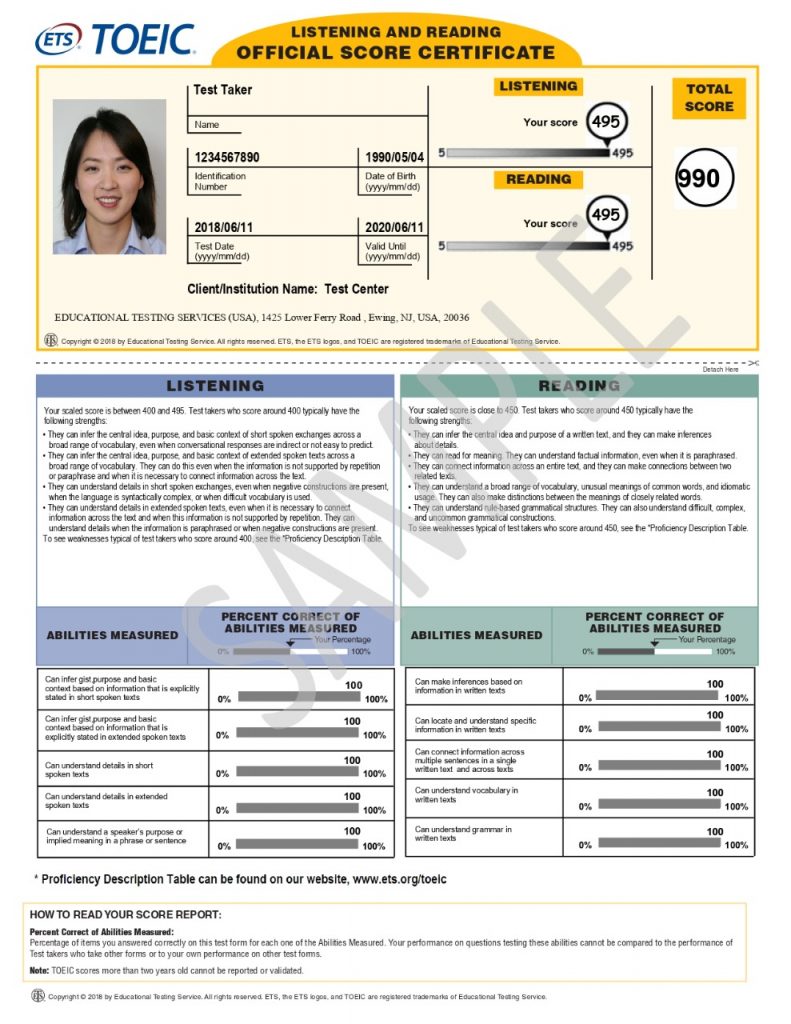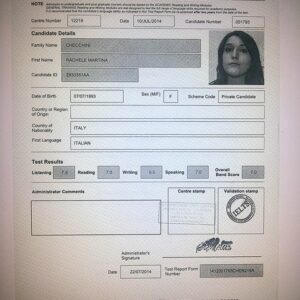Description

Ace the TOEIC: Your Ultimate Guide to Achieving a High Score
Picture this: you’re eyeing that dream job or maybe planning a big move abroad. There’s just one hurdle – a solid TOEIC score. Suddenly, you’re swamped with pressure, unsure where to start. This test can feel overwhelming.
The TOEIC, or Test of English for International Communication, checks your English skills. Many companies and organizations use it to see how well people can use English at work. Students, job seekers, and those seeking immigration often take the TOEIC. They need to prove their English is good enough.
This guide breaks down the TOEIC. We’ll look at how it works, ways to get ready, and tips to boost your score. Getting a high score is doable with the right plan.
Understanding the TOEIC: Format, Scoring, and What It Measures
The TOEIC exam has two main parts. These parts check different English skills. It measures how well you understand and use English in a business setting. Let’s see what each section covers.
TOEIC Sections: Listening and Reading Comprehension
The TOEIC is split into Listening and Reading. Each part tests different skills and has its structure. Understanding these sections helps you prepare better.
The Listening section has 100 questions and takes about 45 minutes. It includes:
- Photos: You’ll hear a statement about a picture and pick the best description.
- Question-Response: Listen to a question and select the most suitable answer.
- Conversations: Hear short talks between people. You’ll answer questions about what they say.
- Talks: Listen to longer talks. Then answer questions about the topic and important details.
Imagine hearing a radio ad for a new product, that would be similar to “Talks”. Or two coworkers discussing deadlines; that is similar to “Conversations”.
The Reading section has 100 questions, too, with a 75-minute time limit. It includes:
- Sentence Completion: Pick the word that best fits in a sentence.
- Error Recognition: Find the mistake in a sentence.
- Reading Passages: Read passages and answer questions to show you get the content.
Reading a company email about a project update would be like “Reading Passages”. Spotting a typo in a memo would be like “Error Recognition”.
TOEIC Scoring System: How Your Score is Calculated
The TOEIC uses a scaled scoring system. Your raw score from each section (number of correct answers) turns into a scaled score. Each section is scored from 5 to 495. The total score ranges from 10 to 990.
A high score, like 900 or above, means you have excellent English skills. This score shows you can use English easily in many work situations. A lower score, like 500, might mean you need to improve your skills.
Your score report tells you about your strengths and weaknesses. It shows how you did in each section. This helps you focus on what to study more.
What the TOEIC Measures: English Proficiency in a Business Context
The TOEIC measures your English ability in a business setting. It focuses on how well you can understand and use English at work. The test checks both listening and reading skills.
Listening skills are important for understanding meetings, calls, and talks. Can you follow a presentation or a phone conversation? Reading skills help you with emails, reports, and memos. Can you understand written business documents?
For example, can you understand a coworker explaining a new project? Or can you read a report and get the main points? The TOEIC checks these types of abilities.
Proven Strategies for TOEIC Preparation: A Step-by-Step Guide
Getting ready for the TOEIC takes planning. It is best to know where you are and build from there. A good plan can make studying effective.
Assess Your Current Level: Identify Strengths and Weaknesses
Start by taking a practice TOEIC test. This shows you your strong and weak areas. Look at your score report to see which sections you struggle with.
Maybe your listening is good, but reading is tough. Or perhaps you struggle with grammar. Focus on fixing these weak spots. Spend more time on grammar or vocabulary if needed.
Set goals that you can reach. If you need a score of 700, plan how to get there. Be honest about where you are starting.
Create a Study Plan: Structure Your Preparation for Success
Make a study plan that fits your life. Set aside time each day or week to study. Consistency is key. Even 30 minutes a day can help.
Here’s a sample weekly plan:
- Monday: Focus on listening comprehension.
- Tuesday: Work on reading comprehension.
- Wednesday: Review grammar rules.
- Thursday: Practice vocabulary.
- Friday: Take a practice test section.
- Weekend: Rest or review weak areas.
Break down your plan into smaller steps. For example, aim to learn ten new words each day. Having a clear plan helps you stay on track.
Utilize Effective Learning Resources: Textbooks, Online Courses, and Practice Tests
Many resources can help you get ready for the TOEIC. Textbooks, online courses, and practice tests are helpful. Pick what works best for you.
Books like “Barron’s TOEIC Superpack” or “TOEIC Official Test-Preparation Guide” are useful. Websites like “Exam English” and apps like “TOEIC Trainer” can help, too. Official ETS materials are the closest to the real test.
Each resource has pros and cons. Books offer thorough explanations. Online courses are often interactive. Practice tests show you what to expect. Use a mix of resources for the best results.
Mastering Key TOEIC Question Types: Tips and Techniques
Different types of questions on the TOEIC require different ways to solve them. Knowing the right tricks helps you do better.
Listening Comprehension: Photos, Question-Response, Conversations, and Talks
Each part of the listening section needs a different method.
- Photos: Focus on the details in the picture. Listen for words that match what you see. Remove answers that don’t fit.
- Question-Response: Listen closely to the question. Think about what kind of answer it needs. Pick the answer that makes sense.
- Conversations and Talks: Listen carefully. Take notes on key points. Answer questions based on your notes.
To improve your listening skills, practice with audio at different speeds. This helps you get used to different speakers.
Reading Comprehension: Sentence Completion, Error Recognition, and Reading Passages
Time is important in the reading section. You have to work fast.
- Sentence Completion: Look for clues in the sentence. Pick the word that fits best.
- Error Recognition: Find the grammar mistake. Know common grammar rules.
- Reading Passages: Skim the passage first. Get the main idea. Then, scan for details.
Learn to spot common grammar mistakes. This will help you in the error recognition part.
Vocabulary and Grammar: Essential Building Blocks for Success
Having a good vocabulary and grammar is key to doing well on the TOEIC.
Learn common TOEIC words like “negotiate,” “contract,” and “deadline.” Use flashcards or apps to remember them.
Understand grammar rules like verb tenses and sentence structure. Do exercises to practice. It’s important to learn words in context. This helps you remember them better.
Minimizing Test-Day Anxiety and Maximizing Performance
The day of the test can be stressful. Know how to handle your time. Use tricks to make smart guesses. Stay calm to do your best.
Time Management Strategies: Pacing Yourself During the Exam
Practice under timed conditions. This gets you ready for the real test. Know how long to spend on each section.
In the reading part, don’t spend too long on one question. If you’re stuck, move on and come back later. Use a timer during practice tests. This helps you track your time.
Test-Taking Strategies: Smart Guessing and Eliminating Wrong Answers
If you don’t know an answer, try to make a smart guess. Remove answers that are wrong. Pick the best choice from what’s left.
Never leave any questions empty. Even a guess gives you a chance. Educated guesses are better than random ones.
Managing Test Anxiety: Relaxation Techniques and Positive Self-Talk
Stay calm during the test. Take deep breaths to relax. Think positive thoughts.
Get enough sleep the night before. Eat a healthy meal. This helps you stay focused. Tell yourself you’re ready. You’ve studied hard and you can do it.
Beyond the Score: Leveraging Your TOEIC Results
Your TOEIC score is more than just a number. It is a tool. You can use it to help your career.
Interpreting Your Score: Understanding Your Strengths and Weaknesses
Your score report shows your strengths and weaknesses. Use it to see what you need to improve. This helps you plan your future study.
See how your score compares to others in your field. This gives you an idea of where you stand. Focus on improving areas where you are weak.
Using Your TOEIC Score for Job Applications and Career Advancement
Put your TOEIC score on your resume. Show it in your cover letter. A good score makes you look better to employers.
A high score can help you get a job or promotion. It shows you have good English skills. This is important in many jobs today.
Continuous Improvement: Maintaining and Enhancing Your English Skills
Keep practicing English after the test. Read English books. Watch English movies. Talk to native speakers.
Make English part of your daily life. This helps you keep your skills sharp. It also helps you get even better over time.
Conclusion
Understanding the TOEIC format is important. Make a study plan. Learn to handle different types of questions. Learn to stay calm during the test.
A high TOEIC score is doable. It takes the right plan and effort. So, get started today and reach your goals.






Reviews
There are no reviews yet.